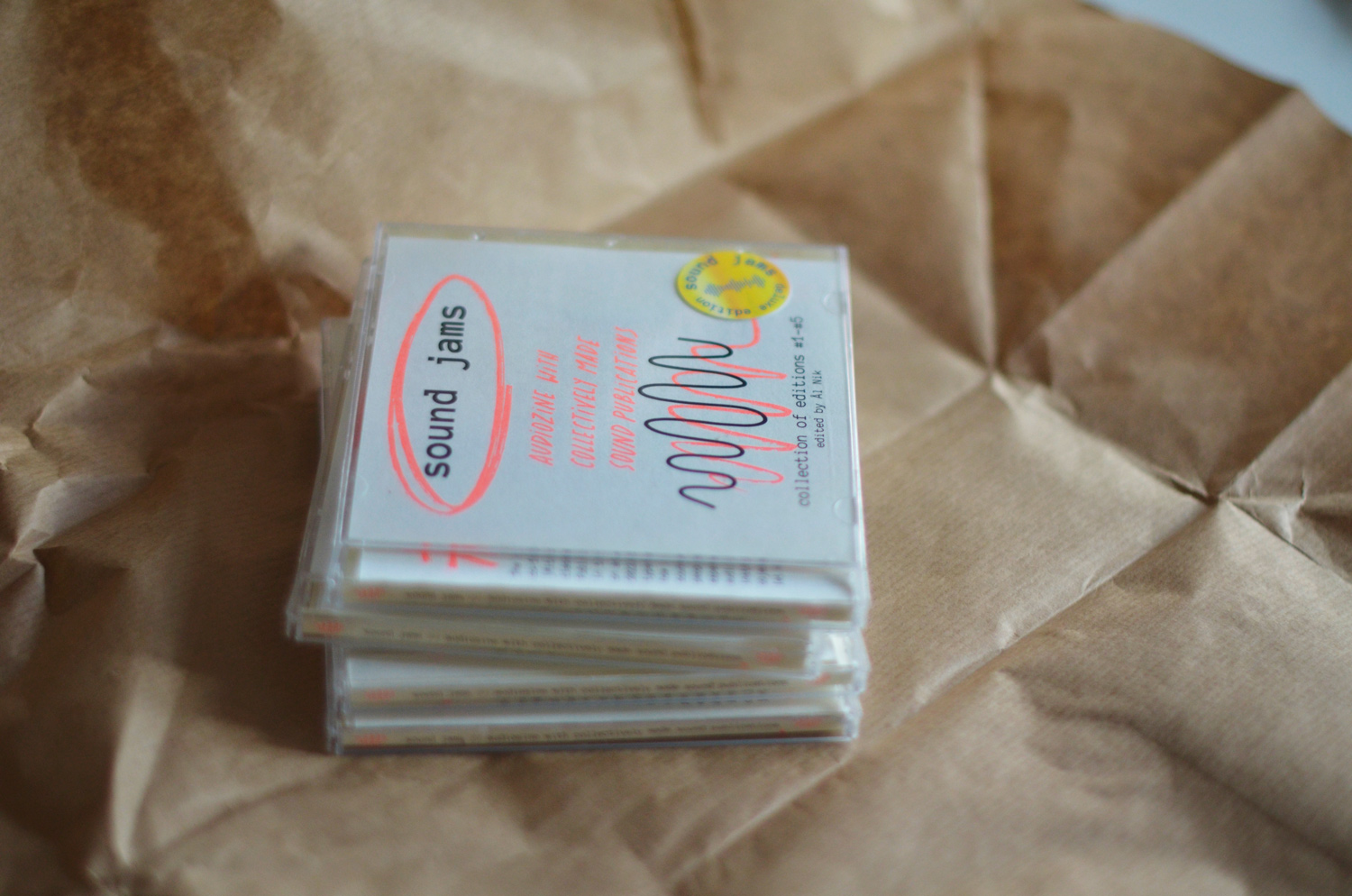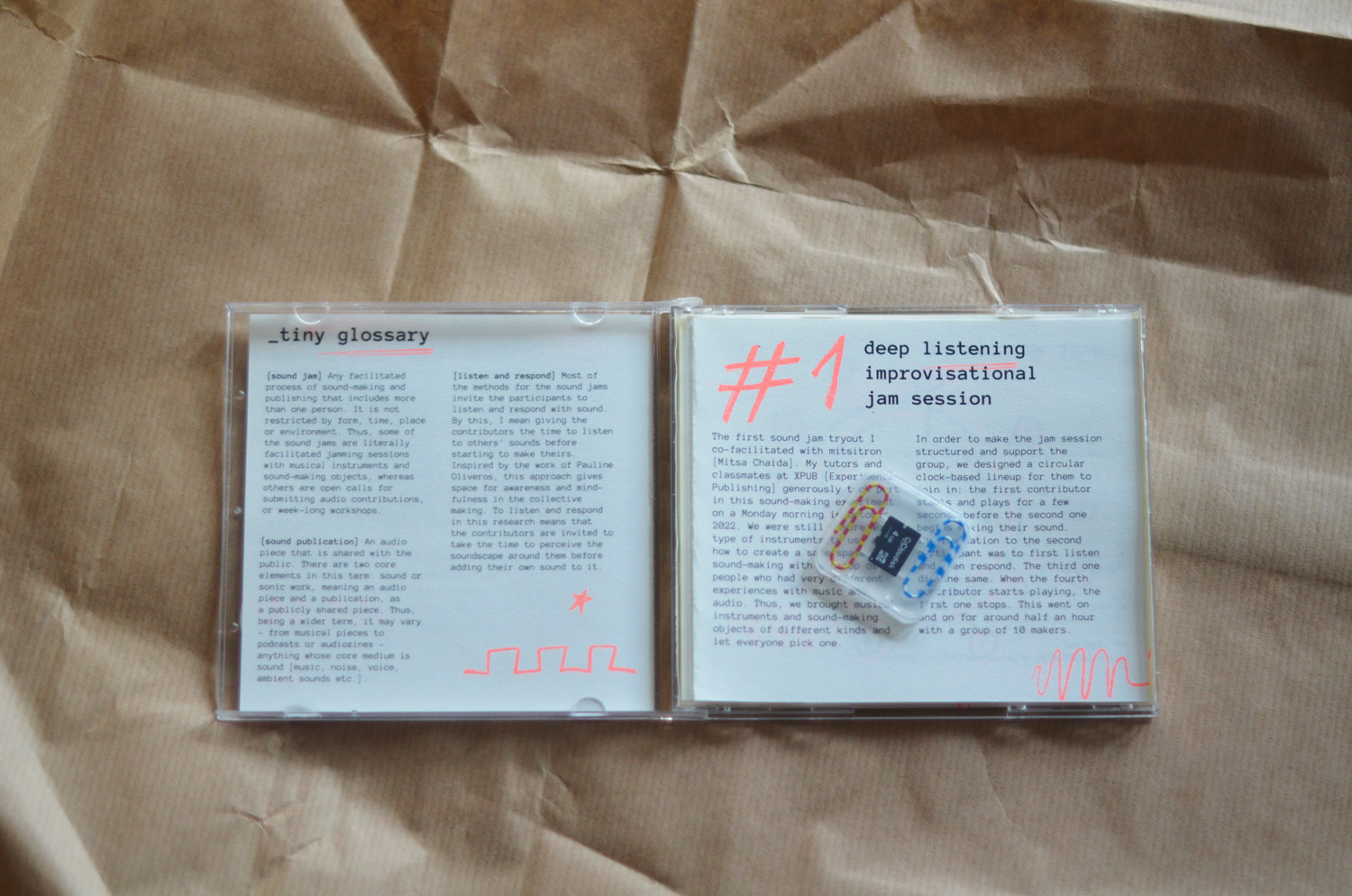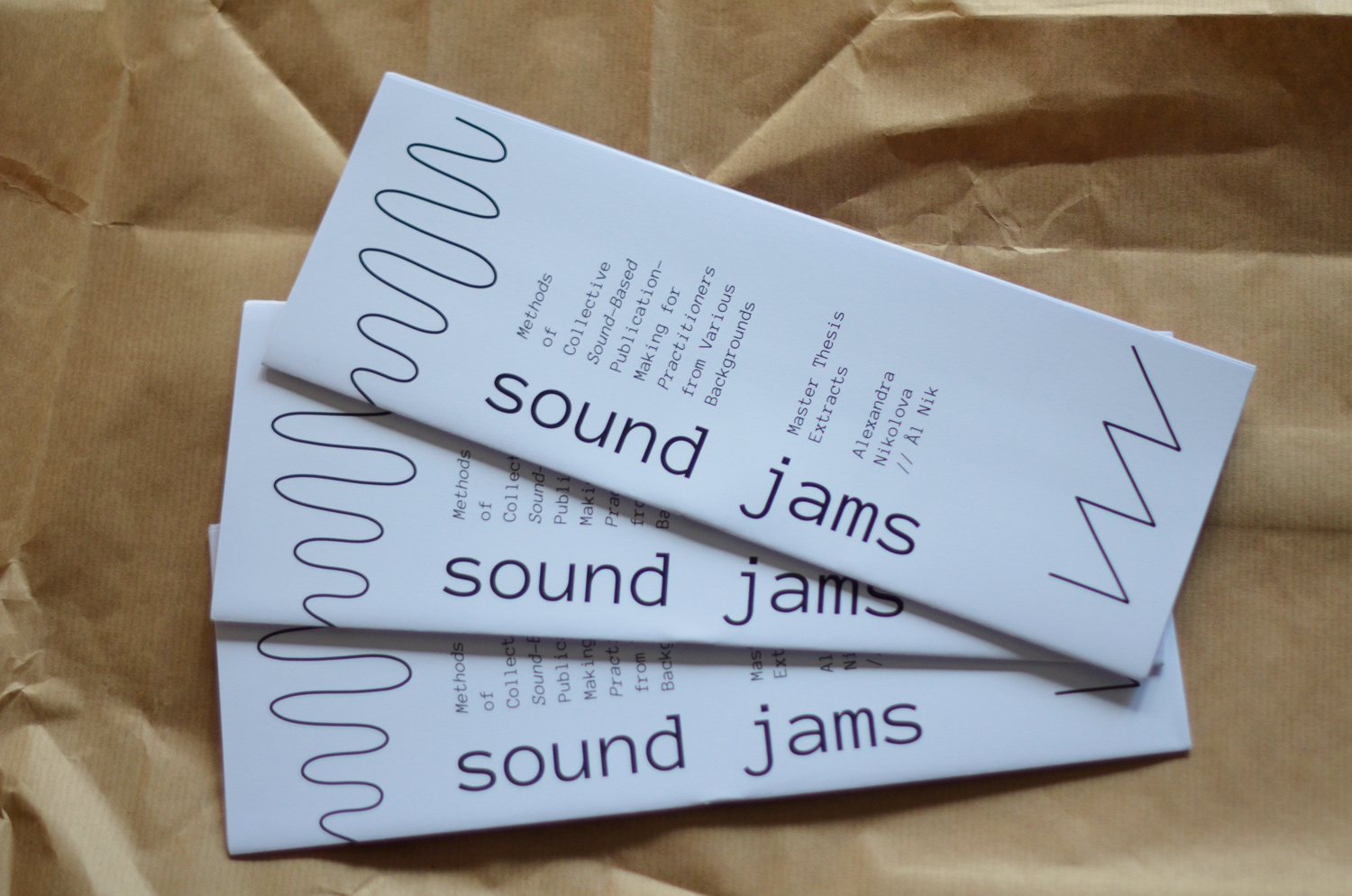Sound jams master's research
Final project - Sound Jams // Deluxe Edition
Sound Jams // Deluxe Edition celebrates the launch of the audiozine - Sound Jams – a series of facilitated collective sound-based publication makings that I started doing as part of my master’s course research. In the CD case, you will find the first five editions of the sound jams: the stories behind the making, highlights from the process, visual scores, illustrations and, of course, the sonic pieces (on the micro SD card as well as accessible through a QR code & web link).
▶▶ The publication is now available on the Underbelly online shop.
What was this project about?
My master's programme research was focused on exploring how to facilitate collective moments of sound-based publication-making. The aim of my graduation project was to accommodate some processes that I tested with groups of people.
We are surrounded by sound on a daily basis and it is a medium that has a major role in the perception of the world around us - with the exception of people with damaged hearing, it helps us navigate through the spaces we are moving around throughout our days. Our bodies are used to perceiving all sorts of sonic signals while orientating in private and public spaces. We hear other people while having a conversation or attending a meeting. We listen to music to relax, dance or distract ourselves. But as a working medium, it still feels quite unattainable for many practitioners: oftentimes, mainly associated with music, it is a reserved territory for people with musical training and for sound artists. In reality, it is far more accessible and there are many ways how sound-making can be open for creators coming from any kind of background. Thus, I am looking at which methods of collective sound-based publication-making can be applied to a group of practitioners from various backgrounds, without the restriction of having experience with sound as a medium in their practice.
In the context of this project, by sound jams, I understand any facilitated process of sound-making and publishing that includes more than one person. They are not restricted by form, time, place or environment. Thus, some of the sound jams are literally facilitated jam sessions with musical and sound instruments, whereas others are open calls on the internet for submitting contributions, or several months-long sound residencies.
Here are the first five sound jams I've facilitated for this research:
▶ sound jams: reversed words // 3~4-2023 // open online call
▶ sound jams: resister at worm // 12-2-2023 // worm, rotterdam
▶ sound jams: transverse atlantis // 16~20-1-2023 // willem de kooning academy, rotterdam
▶ sound jams: what do books say? // 17-10-2022 // leeszaal, rotterdam
▶ sound jams: m&m at pzi // 10-10-2022 // piet zwart institute, rotterdam
Why this?
Facilitation is a substantial element of my artistic practice. Since 2016, I am experimenting with various ways of creating time and space for people to try out new artistic tools, no matter their previous experiences and training. Visual arts and digital communication were mainly the focus of the tools I was researching, but as a mixed-media artist, I am interested in bringing more sound as a format to these laboratories. During the first academic year of my studies at Experimental Publishing, I already noticed my increased interest in using more sound in my artistic practice. Highlights of my research and experiments were the pieces made for Special Issue 18: Radio Implicancies; the care-taking process of facilitating and the editorial work for some weekly releases; as well as participation in improvisational jams with the other XPUB students. I also facilitated my first sound-based artistic residency in September 2022, which allowed me to bring a new medium to my facilitation practice, a medium that worked well in a group of people, and that was a completely new form of expression to many of the participants in the workshop.
This project is also born out of the frustration of feeling oftentimes excluded from jamming sessions because of not being a musician (not having musical training). The element of collective making is also an important entry point for me. I am interested in exploring opportunities for collaborative creative work. I aim at bringing and establishing some principles in my art and facilitation practice: openness, inclusivity, improvisation and collectiveness. I want to create a safe space for experiments, where everyone is welcome, no matter their previous experiences and training.
How did I do my research?
[research of methods for collective sound-making] I started with research of collective-sound-making methods that were inspired by my experiences during the previous year [such as the work on Special Issue #18: Radio Implicancies and the X-unPublic Concert I participated in while in Paris]. Then, I also took the chance to work with Naomi Jansen and co-facilitate an elective class at Willem de Kooning Academy. And of course, I was looking for references and inspirations of sound publications and processes already done by other makers.
[sound jam experiments] Simultaneously, I made several experiments of collective sound-making and publishing between October 2022 and May 2023.
[instruments] Whatever instruments you give to the participants in a jam, shapes the whole experience. However, they were not a focus of this research and the methods I was trying out were meant to work with any kind of sound-making object.
[put things together] Describing the tools for collective sound-based publications making - how can we make sounds together; what are the ways to listen better to each other, to respond with sound, to publish our sound works, to do it collectively? How to create a safe space for people to experiment with a new medium together? I asked myself and others these and many other questions.
Relation to previous practice
[facilitation] Since 2016, I am part of Nomadways collective - an association based in France that designs and implements artistic experimental workshops for artists, activists, and educators - artivists. As a project designer and facilitator, I have experimented with various mediums that we often mix with topic. In our traditionally 2-week workshops, we create space for people to try out new tools and look for ways to implement them in their practice. Adding a whole new library of tools to my facilitation practice is a quite relevant endevour, but sharing it freely with the public is exactly what I am interested in terms of expanding and developing my work.
[sound-based experiments] My complicated relation to music and sound started in my early years of childhood when I was attracted to music but discouraged by my parents to pursue any musical training (they were calling me and my sisters “musical invalids”). Thus, I became a listener. Listening to music and responding to it in my own ways, became part of my daily life. Later, I tried various activities as a user of music: I danced and choreographed; I curated music and performed as a DJ. But my desire to create was never fulfilled. Last September, I co-facilitated together with my friend Bruno Morera - a musician, clown, street performer, and acrobat, who has been facilitating group experiences around Europe - a 2-week music and sound residency in Burlats, France. It was a challenge for me to be a trainer in an Erasmus+ training course and feeling as an imposter because of the lack of training in music. However, it turned out to be liberating.
[xpub year 1] Highlight of my last year was Special Issue 18: Radio Implicancies. As a care-taker, I loved pre-editing, hosting and facilitating a weekly release. As a contributor - to reflect on a read or research with sound. I enjoyed mixing, editing, publishing, but also making and experimenting with sound. I participated in several jamming sessions (such as the X-unPub concert, facilitated by Harrold Schellinx) and felt included. I would like to create such spaces in the future and make that part of my artistic practice.
[visual translation & illustration] are my talents and skills that are always present in my work. They are part of my research, planning but also designing and illustrating the final publication.
Relation to a larger context
[method] The work of Pauline Oliveros was a starting point and an inspiration for me to structure the sound jams. My goal is to create an inclusive space, open for people from any background and without musical training. The practice of deep listening, developed by her, is open to anyone and is based on improvisation. Sound is not limited to musical or speaking sounds, but is inclusive of all perceptible vibrations (sonic formations), which creates a space for openness and awareness.
[inclusivity] In her essay, The Amateur’s Armour, Mariëtte Groot shares how she liberated herself from the pressure of calling herself an artist. She is an active part of Rotterdam’s music culture by running a venue and a shop, booking artists, researching the field of sound art and recently hosting a series of all-female live events at WORM. Her Re#Sister gigs, for instance, are a welcoming space for anyone who defines themselves as a female or non-binary, to join an improvised sound session. Her liberating approach is a great example of how there can be space for people to join music jams with or without musical training, no matter if they call themselves artists or not. Anyone can be a valuable part of the impro moments.
[joy in research] Coming from a very strict, serious and authoritarian educational system, I need to unlearn the maxima that “in order for my work to be valuable, it has to be serious and I have to suffer while doing it”. Writer, activist and facilitator, adrienne maree brown curated a collection of pieces on the topic of pleasure and feeling good in her Pleasure Activism: The Politics of Feeling Good. The understanding that pleasure is a measure of freedom is important for embracing that there should be no shame in activities that make us truly happy. During this research, I am also trying to create moments of joy and release the pressure that comes from other people’s expectations and one own’s self-restrictions.
Who is it for?
_educators: people who are facilitating various educational activities and are looking for ways to bring more mixed media in their activities;
_artists: who are looking for new techniques for their practice and ways to experiment, boost their creative process; to find more ways to reflect over topics and contents;
_collectives: who are interested in exploring new methods of collective making and publishing
Thesis
Sound Jams // Methods of Collective Sound-Based Publication-Making for Practitioners from Various Backgrounds follows my master’s research on exploring ways to facilitate group sound-making experiences. By sound jam, I understand any facilitated process of sound-making and publishing that includes more than one person. Its core principle is inclusivity: it is open to people with or without musical training and offers a structure in which everyone is invited to find a suitable role and space for experimentation. The process grants the makers the opportunity to create a sound publication as a group. This paper explores five sound jams as applied methods that provide such processes and a safe space for makers to open up to a moment of collective sound-making and sharing.
Thesis Adviser // Marloes de Valk
Second Reader // Steve Rushton
References/bibliography
what informed the research:
on facilitation, sound, music & more
adrienne maree brown, (2019). Pleasure Activism. The Politics of Feeling Good. Chico, Edinburgh. AK Press. [annotated pad]
Cardew C. (ed.), (1969). Nature Study Notes. Scratch Orchestra, Experimental Music Catalogue.
Cardew C. (1971). Towards an Ethic of Improvisation. Treatise Handbook Edition Peters
Emiel Heijnen and Bremmer, M. (2020). Wicked Arts Assignments Practising Creativity in Contemporary Arts Education. Amsterdam Valiz.
Evens, A., (2005). Sound Ideas: Music, Machines & Experience. U of Minnesota Press [annotated pad]
Forsyth, Donelson R., and Jeni Burnette. Advanced Social Psychology: The State of the Science. Edited by Roy F. Baumeister and Eli J. Finkel. Oxford: Oxford University Press, 2010. 495-534.
Groot, M. (2019). The Amateur's Armour. [online] Available at: <https://underbelly.nu/wp-content/uploads/2015/04/The-Amateurs-Armour.pdf> [Accessed 11 October 2022].
Hunter, M.A. (2008). Cultivating the art of safe space. Research in Drama Education: The Journal of Applied Theatre and Performance, 13(1), pp.5–21. doi:https://doi.org/10.1080/13569780701825195.
Kreidler, J. (2013). loadbang. Programming Electronic Music in Pure Data. 2nd edition. Hofheim: Wolke Verlag.
La Monte Young. (1963). An anthology of chance operations.
Oliveros, P., (2005). Deep Listening. New York. Deep Listening Publications. [annotated pad]
Runco M.A. and Okuda Sakamoto S. (1993). Reaching Creatively Gifted Students through Their Learning Styles. In Teaching and Counseling Gifted and Talented Adolescents: An International Learning Style Perspective, ed. R.M.Milgram, R.Dunn, and G.G.E. Price, pp. 103-115. New York. NY: Praeger.
Toop, D. (2016). Into The Maelstrom: Music, Improvisation and the Dream of Freedom. Before 1970. New York: Bloomsbury Academic.
Toop, D. (2018). Ocean of Sound. Serpent’s Tail. [annotated pad]
Ross, A. and Gardner, G. (2009). The Rest is Noise. Clipper.
Vis, D. (2021). Research for people who (think they) would rather create. Netherlands: Onomatopee.
Weiss, A., (2001). Experimental Sound & Radio. The MIT Press.
Yōko Ono (1971). Grapefruit. New York: Simon And Schuster.
Yuill, S. (2008). All Problems of Notation Will Be Solved By the Masses. [online] Mute. Available at: https://www.metamute.org/editorial/articles/all-problems-notation-will-be-solved-masses.
sound publications & sonic inspirations
Brown, A. R. (2022). Beneath Maiwar.[online] Available at: <https://www.explodingart.com/arb/2022/06/28/beneath-maiwar/> [Accessed 30 September 2022]. [annotated pad]
Nagy, A. (2018). Hackpact / Sonification Studies. [online] Available at: <https://stc.github.io/HackPact/> [Accessed 30 September 2022]. [annotated pad]
Dust Archive. Youtube channel that publishes music found inside mysterious boxes.
Yannis Patoukas - Jammed
scores & notations
Cardew, C. (2014) The Great Learning, Paragraph 7 (workshop, live) Helsinki, Finland [annotated pad]
Acknowledgements
I would like to express my gratitude to all the tutors who supported me in the process of my research and writing this paper, as well as to the artists and makers who joined the sound jams. Without their input, work, help and feedback, this thesis would not be possible.
my sound jams co-facilitators // Mitsa Chaida (mitsitron) and Naomi Jansen
contributors to the sound jams // Surud Arif, Manetta Berends, Kendal Beynon, Simon Browne, Supisara Burapachaisri, Mitsa Chaida [mitsitron], Kimberley Cosmilla, Lan Dao, Angeliki Diakrousi, Irmak Ertaş, Manan Gadhia, Jian Haake, Stephen Kerr, Chaeyoung Kim, Jette Klaver, Joseph Knierzinger, Nati Lebedeva, Francesco Luzzana, Mathijs, Franciszek Michon, Bruno Morera, Shilen Mujicic, Michael Murtaugh, Ero Petraki, Aglaia Petta, Emma Prato, Yasen Rogachev, Gersande Schellinx, Miriam Schöb, Gustavs Skenders, Arnoldas Sliuzevicius, Boyana Stoilova, Katayun Taraporevala, Can Toksoy, Marie Veldhuizen, Joris Voeten, Luna Vreeburg, Jarmo Willering, Marius de Witte, Iga Wojak, and Alma Zijderveldt
my tutors and supporters // Manetta Berends, Mariëtte Groot & re#sister, Joseph Knierzinger, Bruno Morera, Michael Murtaugh, Leslie Robbins, Steve Rushton, Herald Schellinx, Femke Snelting, and Marloes de Valk


